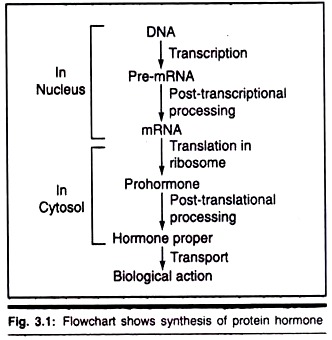ADVERTISEMENTS:
In this article we will discuss about Hormones. After reading this article you will learn about: 1. Definition of Hormones 2. Characteristics of Hormones 3. Synthesis of Hormones.
Definition of Hormones:
Hormones are chemical messengers (may be of proteins, lipids or amines), secreted from special cells of endocrine glands and maintain the physiological activities very specifically on target cells through circulation and disintegrated after action.
Characteristics of Hormones:
The hormones possess the following specific properties:
ADVERTISEMENTS:
1. They are chemical entities produced by special cells of endocrine glands.
2. They are transported to the target cells/ tissue/organ via circulation.
3. Their actions are species specific…
4. They are active in very minute quantities.
ADVERTISEMENTS:
5. They are mostly water soluble.
6. They are low in molecular weight.
7. They are destroyed after their actions.
8. Chemically they are heterogeneous substances.
9. They cannot be stored for a longtime; usually they are synthesized and secreted during the time of requirement.
10. They usually activate target cells by forming hormone receptor complex.
Synthesis of Hormones:
Hormones are involved in coordination of series of physiological events. The synthesis of all hormones is determined at the genetic level.
1. Synthesis of Peptide Hormones:
Peptide hormones are synthesized by translational method. Several steps are involved in the transfer of information (gene expression) encoded in the polynucleotide language of DNA to the poly-amino acid language of biologically active proteins (hormones).
ADVERTISEMENTS:
The formation of polypeptide hormones involves the initial formation of a parent molecule, called pro-hormone. As a result of post translational changes, such as cleavage by enzymes, the pro-hormone is broken up to form hormone itself.
It is observed that according to genetic code protein synthesis takes place in ribosomes after transcription. This is known as pro-hormone which is extended at their amino termini by a hydrophobic amino acid sequence, called signal peptide or leader peptide.
With the help of signal peptide pro-hormone passes into the Golgi complex via endoplasmic reticulum. The pro-hormone is then converted into hormone proper by enzymic action and finally secreted by exocytosis. Following schematic representation shows the steps in cellular synthesis of peptide hormone (Fig. 3.1).
2. Synthesis of Non-Peptide Hormone:
ADVERTISEMENTS:
The synthesis of non-peptide hormones such as, thyroid hormones, adrenal medullary hormones, steroid hormones involves the action of multiple enzymes. Thyroid and medullary hormones are basically derived from the amino acid tyrosine.
All the steroid hormones are synthesized from precursor cholesterol molecule. Synthesis of non-peptide hormones occurs within the cells from their precursor molecules by sequential actions of several enzymes. They may be synthesized within mitochondria or within endoplasmic reticulum. They are then secreted either by active exocytosis or by simple diffusion.
Transport and Metabolism of Hormones:
ADVERTISEMENTS:
Most of hormones after secretion are directly poured into the blood stream and reach the target organ via circulation or it may be bound to a carrier protein. Sometimes hormones are transported through intercellular fluid, specially in paracrine secretion.
Hormones are metabolically degraded after their action. During metabolism of hormones, the molecule may be altered, consumed at the site of action. Usually degraded in the liver and kidney, then excreted through urine. Peptide hormones are digested and converted into individual amino acids in lysosomes.

